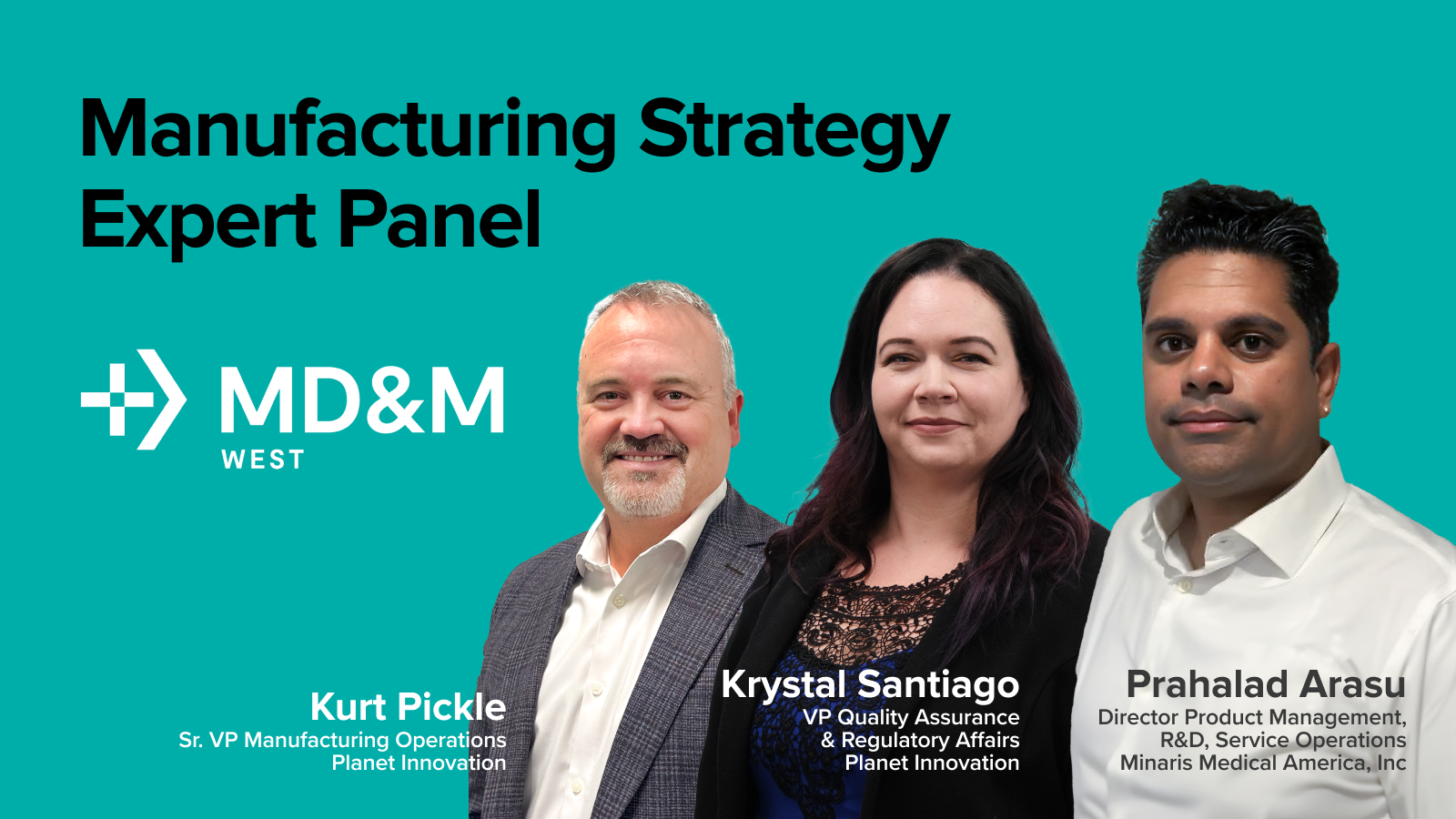



When you’re transferring a new product into production there is often a lot of uncertainty. Untested market demand, regulatory changes and supply chain disruptions are just some of the challenges facing medtech companies as they transfer to manufacturing. However, there are steps you can take to future-proof your manufacturing strategy.
I recently discussed this topic at a panel discussion at MD&M West with Krystal Santiago, VP Quality Assurance and Regulatory Affairs at PI, and Prahalad Arasu, Director Product Management, R&D, Service Operations at Minaris Medical America. We discussed various ways that companies developing and manufacturing medtech devices can make good, strategic decisions, that future-proof them against changing regulatory and market conditions. It was an insightful discussion with Krystal providing a regulatory and quality lens, Prahalad bringing lived experience as a diagnostics developer working with contract manufacturers, and myself with both product development and manufacturing experience. Here is a summary of what the three of us discussed.
Prahalad:
Some things to consider in design for manufacturability are: How do you manage COGs? What do your sub-modules look like? Do you have sub modules that get quality controlled and then go into your final assembly? Sometimes it can be as simple as how complex your wiring is.
Your goal should be a product that can be manufactured consistently with minimal quality issues. It’s really important at the design phase to not only look at what the product does, but how it can be built consistently.
That’s why we would go through a contract manufacturer. Especially one that has a really strong design team that’s tied to the manufacturing side. We’ve previously had problems when the design team and the production team were siloed, which led to all sorts of problems when the product moved into production. If you’re going to go through all the way from conceptualization to transfer, you need to make sure that your contract manufacturer is in sync on the design side and transfer side and that they have that constant feedback earlier in the process, so that you’re not transferring something to production that’s going to be really hard for them to manage.
Krystal:
From the compliance side, some things to consider are:
During the design process it’s important to get a minimal viable product out, but in parallel you have to start thinking about getting approval. Submitting a 510k submission to the FDA is not something to be feared, but it can be overwhelming if you have lots of changes. Also, the FDA or your notified body (if you’re in the EU) start to notice if you have to do lots and lots of product changes, which doesn’t make your design process look good. They’re more apt to take a look at this if they notice you’ve had lots of change notifications over a product that they just approved because it means you probably didn’t do a fantastic job up front. There are lots of different sides to balance. I’m a big fan of doing an MVP, but keeping a high visual horizon on what the next 12-18 months look like when it’s in production. That way you can manage your change notifications and your dealings with the regulators
Kurt:
One of the things I’ve noticed is that often new instruments come out and I think many companies miss that they have to educate the market. They’re overly optimistic for their first-year volumes as they’ve missed the piece in the beginning to educate the market and it’s going to take a little bit longer for pick up.
Krystal:
You have to balance cautious optimism in thinking you’re going to hit the ground running and everyone’s going to buy it, with the level of evidence that you’re going be able to provide to the people who do want to buy it. A lot of products, especially if they’re cutting edge, need more than a sales pitch to get people to buy it. They need strong evidence of product performance in a real world environment, and a commercial business case demonstrating the financial impact of the product in a customer environment. I think the effort to get a new product into the marketplace is often underestimated. It’s not necessarily bad to have the optimism, but it does affect your pipeline into your manufacturing and what your volumes look like.
Prahalad:
You have to have some level of confidence in your understanding of the market to control your inventory volumes and your supply chain, and in terms of obsolescence as well. If you source something that was end of life and then you have to do a design change midway through that can affect your supply chain as well. If you have complications in terms of the replacement component, the scope of V&V (verification and validation) can be a little bit tricky. I think it goes back to understanding what your market opportunity is for your product.
If you do need to do an end-of-life, one-time purchase because you want to map that out and buy yourself time for your first one or two years in the market, you can do that and then that at least saves you some time on the back end to meter that change in. I think you have to really understand what your market size is and then understand where you want to take risks based on your components.
Krystal:
I’d suggest for companies like that to do a batch build towards the beginning of their product so that they can get enough to get it out on the market and get the feedback that they need. There’s almost inevitably going to be some level of tweaks that have to happen to the product once it’s gone through its soft launch or initial launch. For people who are in that novel space and do have to do a bit of the selling, it makes more sense to have a batch of product that they work off of, until they know that they need demand.
Prahalad:
The batch build makes sense. You’re trying to freeze design so you can move forward with your data collection. It’s important to test the market assumptions before the soft launch and then use the soft launch to gather true customer feedback on the product.
How flexible is the initial design to make modifications to the system? Ideally, you can map out potential options in advance so you can better understand change order costs, adjustments to the design and potential challenges on supply chain if there are changes. The sooner you can get to market the sooner you can get feedback on your initial design, but you also have to be cognizant of market acceptance and the ability to make changes, both financially and from a regulatory perspective.
Prahalad:
I’d look at how in sync the design team is with the design transfer team and the manufacturing side. I’d want to see success stories.
I think ‘like size-fit’ helps too. If you are a smaller company and the contract manufacturer is on the larger size, you want to make sure that there is the right kind of fit there in terms of the project team you’ll get.
As the client, it’s important to understand where your gaps are and does the contract manufacturer you’re selecting offset them. You have to have self-awareness in terms of where you’re going to need help on the project and be transparent with the contract manufacturer about that so that there’s less scope change in the project. If you’re not honest with yourself up front and think you know everything, you’ll find there are gaps when you set up your requirements. Then a Phase 1 that you thought was going to take two months, ends up taking six to eight months. There’s a lot of different things I think that are important when you’re picking a contract manufacturer, but a lot of it comes with understanding where you are and your strengths and weaknesses as the IVD manufacturer as well.
Krystal:
At PI, I think that we’ve seen different use cases for contract manufacturers. We have large multinational corporations that come to us because we’re more nimble and agile than they are. They might not use us for a full transfer to manufacturing, but they do use us for some of the design for manufacturing as well as the design side of things.
Like Prahalad mentioned, there’s benefits to having both design and manufacturing internal, so look at how closely they are connected.
The other use case for a contract manufacturer is a smaller company that has a multi-factorial platform, where they might be willing to bring in the test strips or something like that where they want to control that tightly, but they don’t want to build an electromechanical floor in order to make the instruments. Outsourcing to somebody who has expertise in that and has the supply chain as well as all of the tools available for that makes sense because you’re going to end up with a better product at the end using somebody who’s focusing in on that all the time, rather than trying to diversify yourself.
You should be looking for a contract manufacturer that has a wide variety of skills that are available to them, or levers that they can pull in order to make your projects successful. Try to match the skill set of the contract manufacturer or innovation house. If you’re making a regulated product, go to a contract manufacturer who has some of that background. If you’re making a something that’s not regulated, go to somebody who’s very quick on their feet. Startup companies can’t cover everything. As Prahalad commented, it’s not feasible yourself and nor should you even attempt it, because you will likely not do it as well as somebody that is built for that.
Kurt:
You’re looking for a contract manufacturer that you can leverage their expertise and knowledge in areas where you might not have that capability or knowledge. I worked on a project where we’d never made reagent before so taking that on internally would have been quite difficult to do. We looked for a contract manufacturer that did that for other companies. It fit their expertise. They had that right wheelhouse, and they were able to scale up much faster than we could have if we had to start from scratch.
What I’m hearing from the panel is to really understand who the contract manufacturers are and where their expertise lies, particularly if they have the broad knowledge and broad capabilities to help leverage your organization to be the most successful.
Moving a new product into manufacturing is an inherently uncertain time, particularly if you have a novel product with untested demand. However, as the panel discussed, there are steps you can take both during design and transfer to manufacture that can help minimize the risk and future proof against changing regulatory and market conditions. Some key things include: considering the manufacturability and compliance of your product during the design phase; having a solid understanding of your market and the effort required to sell a new product; doing batch builds when you’re first entering the market with a new instrument; and partnering with a manufacturer that has capabilities and expertise that complement your own. This will give you the best chance of commercial success when appointing a contract manufacturer and launching a new product.
Want to learn more about manufacturing at Planet Innovation? Check out our Manufacturing page or get in touch.
PI offers the full spectrum of product development and manufacturing capabilities needed to create and commercialize sophisticated, connected products. We can help you with any or all of your needs – from identifying a market opportunity, through design, engineering and digital, to manufacture and commercial launch. Our flexible approach and ability to scale support means we can tailor our services to suit your needs
Let’s talk